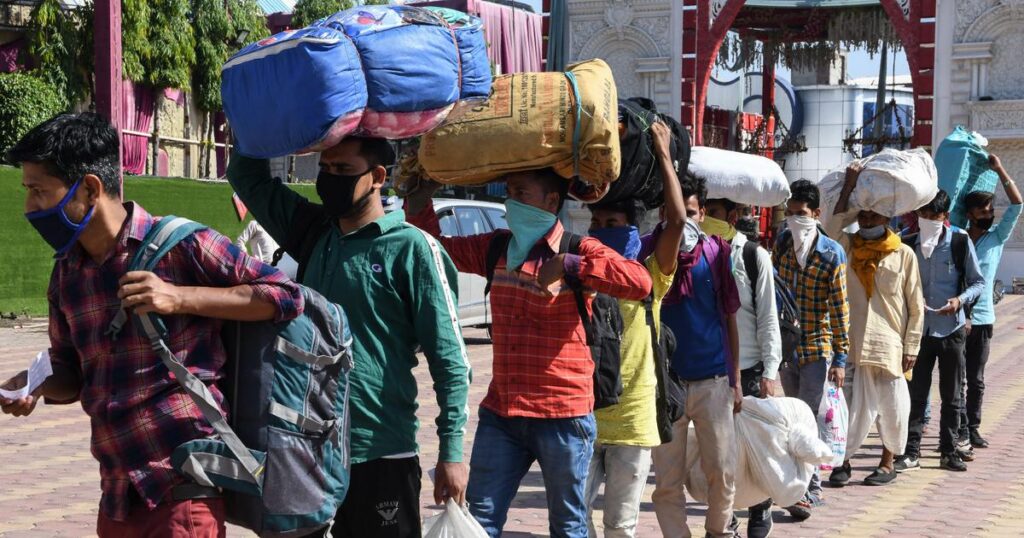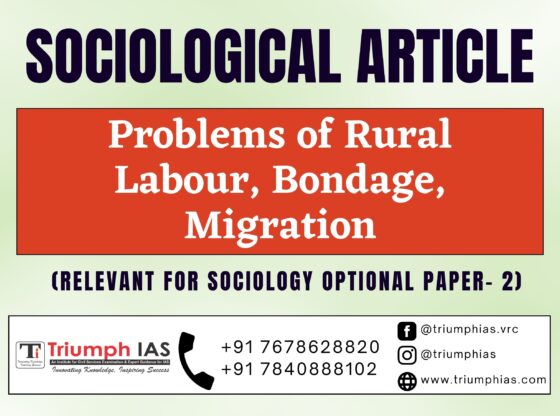Problems of Rural Labour, Bondage, Migration
Relevant for sociology optional Paper- 2 (Unit- 13 : Social Changes in India)

Rural labour, bondage, and migration are persistent and complex issues in India. Despite the significant economic growth and development witnessed in the country, these problems continue to afflict the rural population, especially those who depend on agriculture and allied activities for their livelihoods. The issues of rural labour, bondage, and migration are interconnected and require a comprehensive approach to tackle them effectively. This essay explores the challenges associated with these issues, their causes, and possible solutions.
One of the significant challenges of rural labour in India is the low wages and poor working conditions. The agricultural sector, which is the primary employer of rural labour, has traditionally offered low wages and meager social security benefits. Moreover, labour laws in India are not effectively enforced in rural areas, resulting in the exploitation of workers. Many rural workers are employed on a daily wage basis, which provides them with little job security and no access to benefits like healthcare, pensions, and insurance. This precariousness makes it difficult for rural workers to improve their living conditions, which perpetuates poverty in rural areas.
Another critical issue associated with rural labour in India is bonded labour. Bonded labour is a form of modern slavery where people are forced to work in exchange for the repayment of a debt. Bonded labour is prevalent in rural areas, where poor people are often unable to secure loans from formal institutions and end up borrowing money from local moneylenders at high-interest rates. The borrowers are then forced to work for the moneylender until the debt is paid off, which can take years. The practice of bonded labour is illegal in India, but it continues to exist, especially in rural areas.
The problem of rural labour in India is further compounded by the issue of migration. Rural-urban migration is a common phenomenon in India, with millions of people moving from rural to urban areas in search of employment opportunities. The lack of job opportunities in rural areas is a significant driver of rural-urban migration. However, urban areas are often ill-equipped to handle the influx of migrants, which leads to the formation of slums and other informal settlements. These settlements lack basic amenities like clean water, sanitation, and healthcare, which puts the migrants at risk of disease and other health issues.
The migration of rural labourers to urban areas is not only an issue of concern for urban areas but also for rural areas. The migration of young and able-bodied workers from rural areas has significant implications for agriculture and other rural industries. The shortage of labour in rural areas can lead to a decline in agricultural productivity, which can have severe consequences for food security and rural livelihoods.
The problems of rural labour, bondage, and migration in India have multiple causes. One of the main causes of low wages and poor working conditions in the agricultural sector is the lack of bargaining power of rural workers. The fragmented nature of agricultural landholdings in India makes it difficult for workers to organize and negotiate better wages and working conditions. Moreover, the government’s policies have been skewed towards urban development, with little focus on rural development. This has resulted in a lack of investment in rural infrastructure and services, which has contributed to the migration of rural labour to urban areas.
The issue of bonded labour in India is closely linked to poverty and the lack of access to formal credit. Many rural people are unable to secure loans from formal institutions due to their lack of collateral or credit history. As a result, they are forced to borrow from local moneylenders who charge exorbitant interest rates. The borrowers are then trapped in a cycle of debt, which often leads to bonded labour.
The problem of migration in India has its roots in the uneven distribution of economic opportunities and development across the country. The lack of job opportunities in rural areas and the concentration of economic activity in urban areas has created a significant urban-rural divide. Moreover, the lack of infrastructure and basic services in rural areas has also contributed to the migration of rural workers to urban areas.
To address the problems of rural labour, bondage, and migration in India, a multi-pronged approach is required. Firstly, the government needs to invest in rural infrastructure, such as roads, irrigation facilities, and healthcare, to improve the living conditions of rural people. This will not only provide better living conditions but also create job opportunities in rural areas, which will help stem the tide of migration to urban areas.
Secondly, the government needs to enforce labour laws more effectively, particularly in rural areas. The government needs to ensure that workers in rural areas receive fair wages and working conditions and that their rights are protected. The government should also provide social security benefits to rural workers, such as healthcare, pensions, and insurance.
Thirdly, the government needs to take a more active role in providing credit to rural people. The government should encourage the formation of cooperatives and self-help groups to provide credit to rural people at reasonable interest rates. This will help to reduce the reliance on moneylenders and reduce the incidence of bonded labour.
Fourthly, the government needs to focus on creating job opportunities in rural areas. This can be done by promoting rural industries, such as food processing, handicrafts, and textiles, and by providing training to rural workers to equip them with the skills needed for these industries.
Lastly, the government needs to take steps to bridge the urban-rural divide by promoting balanced economic development across the country. This can be done by providing incentives for industries to set up in rural areas and by investing in rural infrastructure and services.
In conclusion, the problems of rural labour, bondage, and migration in India are complex and require a multi-faceted approach to tackle them effectively. The government needs to invest in rural infrastructure, enforce labour laws, provide credit to rural people, create job opportunities in rural areas, and promote balanced economic development across the country. Only then can we hope to address these issues and create a more equitable and prosperous society for all.
For more such free UPSC notes, Articles, News & Views Join our Telegram Channel. https://t.me/triumphias
Click the link below to see the details about the UPSC – Civils courses offered by Triumph IAS. https://triumphias.com/pages-all-courses.php


